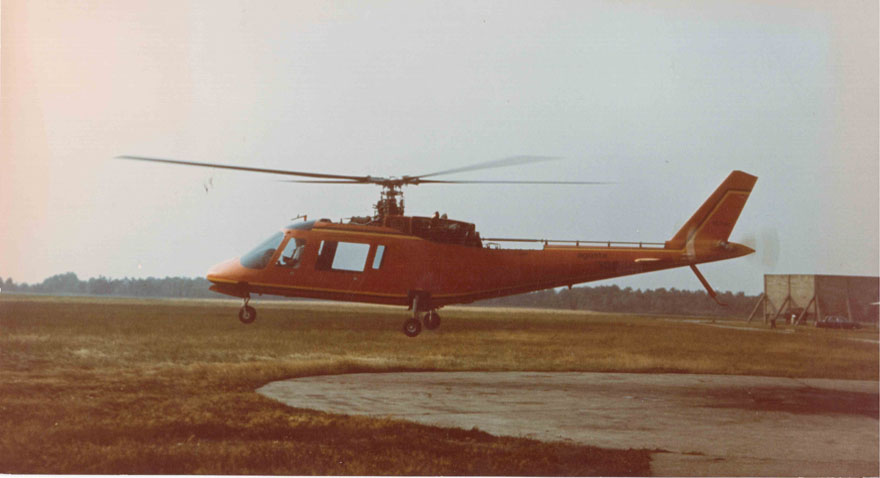They both made history in rotary-wing aircraft, with small but important revolutions that contributed to our company’s positioning and leadership in the industry.
These are the Agusta A109 and Westland Lynx helicopters, two iconic Leonardo models which share a very special anniversary this year: the 50th anniversary of their first flight. On August 11, Lynx also celebrated another historic date: setting a world speed record 35 years ago, which is still unbeaten today.
A109: A revolutionary new helicopter
Top performance and speed, elegant design for superior aerodynamics, mission versatility and a high degree of customisation.
These are only a few of the keys to the success of the A109, which, with its first flight 50 years ago, marked the beginning of a success story that ended up leading our company to develop a vast and continually growing range of multi-role and dual-use helicopters, now at the service of operators all over the world.

The first flight of the A109
On 4 August 1971 the A109, the first all-Italian twin-engine helicopter - conceived, designed and built entirely by what was then Agusta - took off on its very first flight. It was San Domenico day, in honour of Domenico Agusta who authorised construction of three prototypes for certification in response to the request of engineer Bruno Lovera. At the controls was test pilot Ottorino Lancia.
Following this first flight, studies and tests continued with the aim of coming up with a final version with a four-blade articulated main rotor, semi-rigid two-blade tail rotor, fuselage and tail boom made of light alloy, featuring fully retractable landing gear to ensure unique handling and overall flying qualities. This was the version that provided the basis for all future developments.
The A109 was the first Italian-designed helicopter to obtain RAI (Registro Aeronautico Italiano) certification; the process was conducted in parallel with the US authority FAA (Federal Aviation Administration), leading to double certification in 1975 for the 2.4 tonnes, 8-seat model.
This marked a turning point for our company, which, after a series of attempts with projects that stopped at the prototyping stage, went from producing helicopters on licence to making its own helicopters, becoming one of the world’s most important helicopter OEMs (Original Equipment Manufacturers). The new model also allowed the company to enter the US market, setting up a logistics centre in Philadelphia which was, in the decades that followed, destined to become Leonardo’s industrial pole for the manufacture of helicopters in the United States, for complete production of rotary-wing aircraft and support and training services.
A world-wide success
The first deliveries to government clients in Italy and abroad began in 1976: a series of versions and new certified types for civil, public service and military applications, marking the company’s constantly growing presence on the light twin engine segment all over the world.
The latest new models in the 3-tonne class include Power and Grand, and the more recent GrandNew and Trekker in addition to military and government versions such as LUH (Light Utility Helicopters) and Nexus.
This is a product that has always managed to renew itself and innovate continually, coming up with radically different models and becoming an icon of flexibility, ingenuity and innovation, fully responding to the needs of all kinds of operators: recent projects saw, for example, the introduction of modern digital avionics, spacious cabins, more modern dynamic components and new engines. More than 1,600 light twin-engine helicopters have been sold in the past 50 years, to customers in more than 50 different countries.
The A109 is on display in the Agusta Museum in Cascina Costa di Samarate (VA); there are also specimens in Volandia Flight Park and Museum (Somma Lombardo, VA) and in Leonardo da Vinci National Museum of Science and Technology in Milan.
Lynx: record-breaking innovation
Fifty years ago, on 21 March 1971, a bright yellow prototype of the Lynx Westland (XW835), a multi-role medium light helicopter, took off on its first flight from our Yeovil site, completing two brief flights of ten and twenty minutes. The aircraft was piloted by head test pilot Ron Gellatly. This marked the beginning of Leonardo’s leadership in this category, playing a key role in the defence of the United Kingdom with the production of the first Naval Lynx (XZ227), delivered to the Royal Navy on 8 July 1976.
Hence the iconic status of this aircraft, which, like the A109, ushered in a new era for our company and confirmed its leadership in this segment of the market up to the present day, with the new AW159 picking up on its legacy, integrating the most advanced technologies available today - a state-of-the-art cockpit with big displays, avionics and fully integrated mission systems - to ensure advanced situational awareness and greater operative efficacy under extreme meteorological and environmental conditions.
More than five hundred aircraft in the category were purchased, in various versions, by operators all over the world to fight surface and underwater threats, and for search and rescue, coastal protection and utility purposes. These include the Brazilian navy – which has been using our helicopters for more than four decades - the Malaysian navy and the South African Air Force.
The world’s fastest helicopter
Thirty-five years ago, on 11 August 1986, a Westland G-Lynx flew 15 km over the Somerset skyline to set a record as the world’s fastest helicopter, with a top speed of 400.87 km/h (249 knots). This was made possible by introduction of new technologies such as BERP (British Experimental Rotor Programme) blades permitting increased speed and improved lifting capabilities. These blades were then adopted on all Lynx and Super Lynx versions and AW101 helicopters.
A record-breaking speed it shares with the A109. In 2008, a direct descendent of the A109, the Grand, set another world speed record, flying around the world in 11 days.
Two success stories, each unique, featuring the A109 and the Lynx: helicopters that made the history of our company, marking the most significant milestones in helicopter production and illustrating our capacity to innovate.

